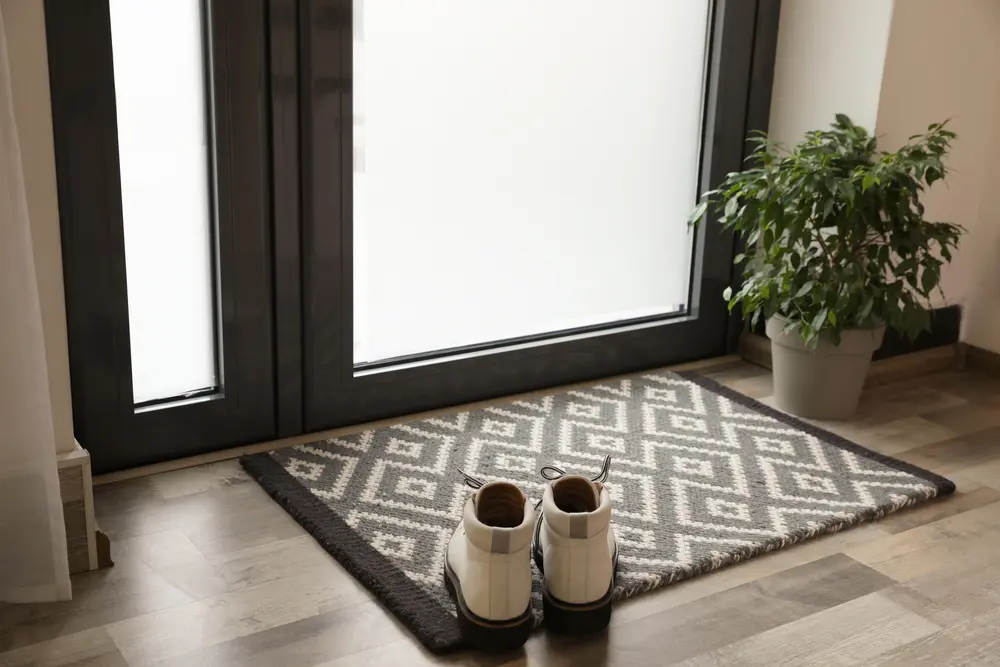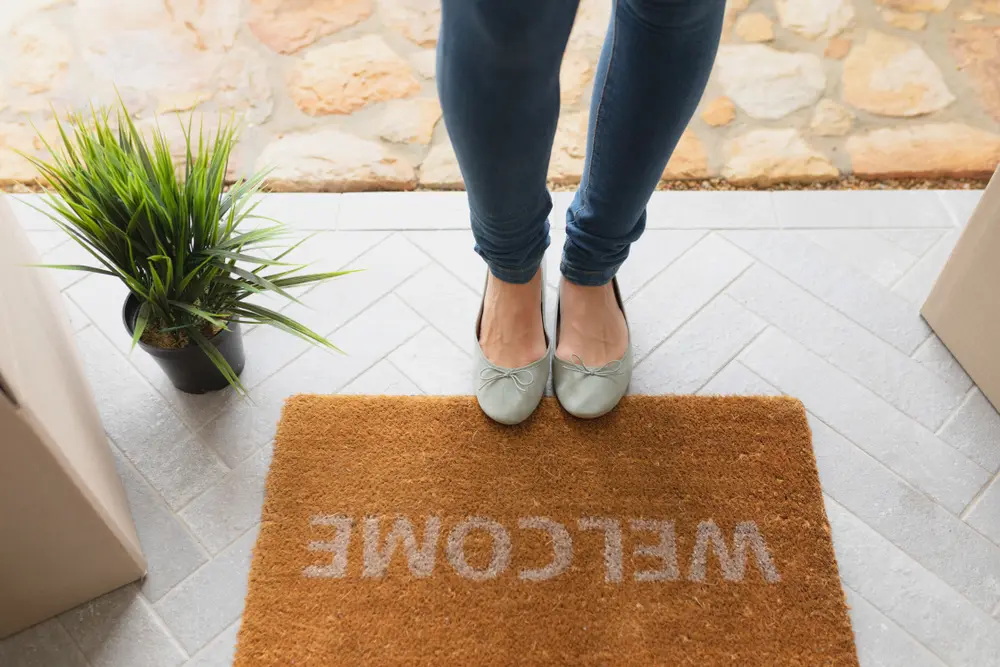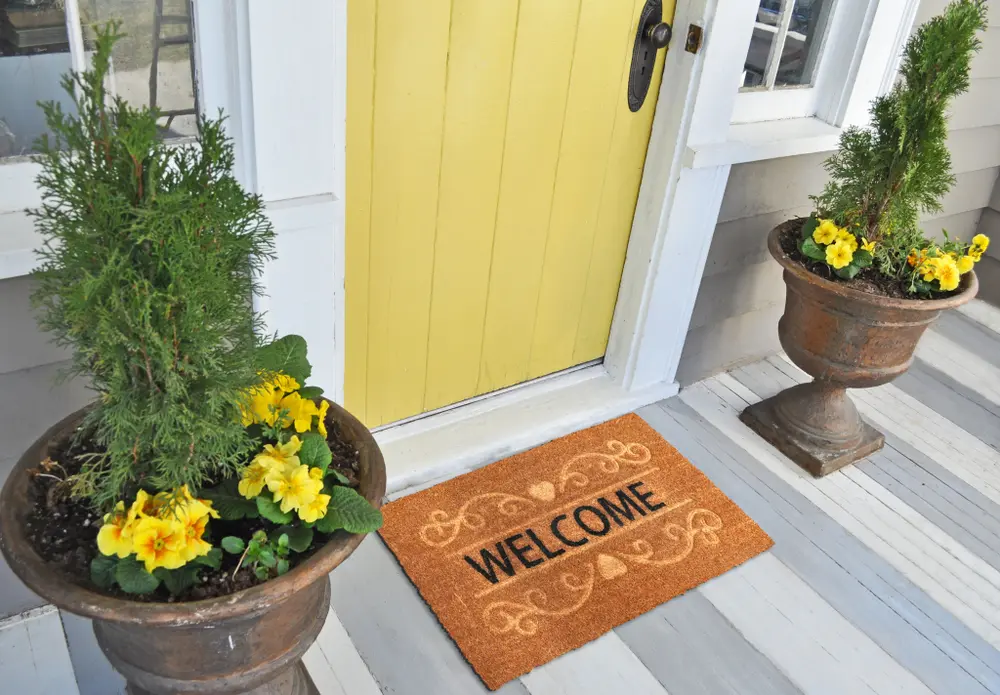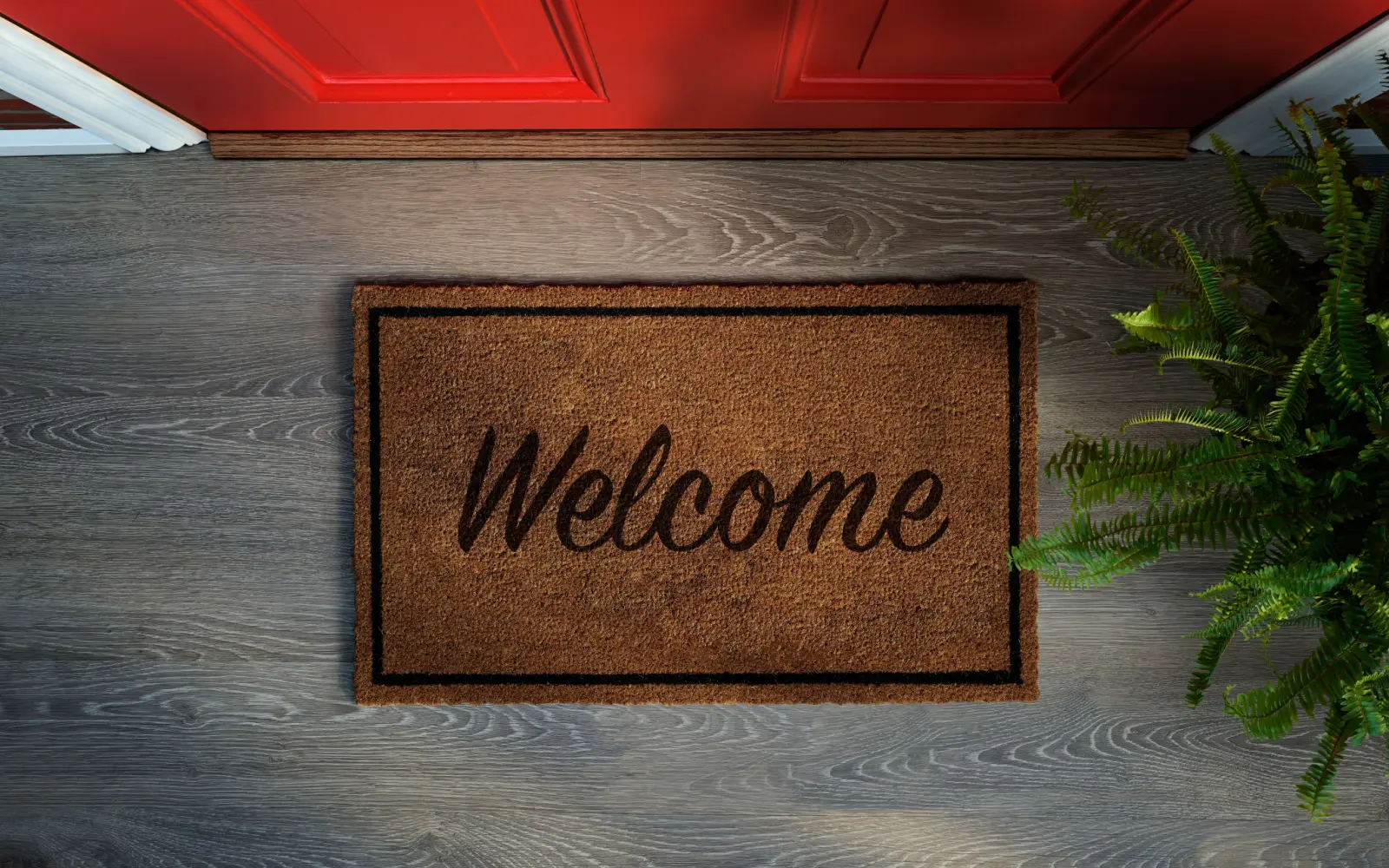A door mat is the first thing a person sees as it welcomes them into your home.
It’s your home’s first impression, so it’s up to you to choose one that will fit the space and represent your aesthetic.
When buying a door mat, it’s essential to find the appropriate sizing, but what is a standard door mat size?
Keep reading to find out more about the best door mats to purchase and why you need one.
What Is a Standard Door Mat Size?
In general, the standard door mat size is 18 by 30 inches. Although this doesn’t seem like anything too big, a door mat can have more uses than just decoration.
This size is perfect for the outside of your door, as most doors are the same standard width.
Door mats also help keep dirt outside and decrease the chance of dirt and mud being tracked inside the house.
Why Use a Door Mat?

New Africa/Shutterstock
- Prevent floor damage
- Safety
- Improve indoor air quality
Prevent Floor Damage
The coverage provided by the door mat decreases the chance of damage to the floor and surrounding ground foundation.
Often, water and dirt can seep into the flooring foundation, create cracks, and weaken the ground, causing it to crumble.
This protective measure of a door mat ensures a barrier between the ground and any external conditions outside that you can’t control.
It’s easier and cheaper to wash the door mat when it gets too gross than to hire someone to fix the floor foundation.
Safety
Door mats often help with preventing slips and falls, especially when it’s raining or snowing out. Suppose your flooring is hardwood floor when you step inside the house.
Wood and tile are already slippery materials, so when guests walk into your home, it’s easy to trip and slide against the floor if they track in dirt and water.
The door mat provides a place to wipe off the dirt before walking inside, preventing any safety hazards, which will also provide more traction and friction when you step on the flooring inside without anything or material coming in between your shoes and the floor.
Improve Indoor Air Quality
The debris and dirt you bring into your home without a door mat increases dust and bacteria in the air ducts. Dirt and mud from outside needs to stay outside, as it doesn’t just prevent your house from becoming grimy.
It also increases circulation and reduces the house’s struggle for good air quality.
When dirt seeps through from outside via your shoes, there’s more of a possibility that it will circulate up from the fan and air conditioning into the air vents, which triggers the air quality inside.
Things to Consider

Wavebreakmedia/Shutterstock
When in the market to buy a door mat, there are a couple of things you should consider to get the best door mat for your home.
Here are some of the characteristics and things you should keep in mind:
- Placement
- Thickness
- Maintenance
- Size
- Purpose
Placement
It’s important to consider placing your door mats outside rather than inside your house. From the above explanations on what door mats prevent and help avoid, they are most beneficial when placed outside the house near the door.
When considering placement, which will most likely be outside, it’s also important to figure out what features you need when buying a door mat.
For an outside door mat, it’s recommended to buy one with waterproof features and one that can drain easily.
The material best used for this is usually rubber, but the door mat might have the features explained on the mat specifically.
Thickness
Thickness depends on how high your step into your house is and whether or not you want it to be close enough to the height to prevent tripping.
You should also assess the thickness of an outside door mat based on how easy it will be to wring out the water and squeeze the excess dirt and rainwater off.
The thinner the mat, the easier it is to squeeze out the water, and comfort isn’t important in this situation due to only being on the mat for a couple of seconds before coming inside the house.
Maintenance
Depending on the mat’s material, some are easier to clean and keep in good condition compared to others. The thinner the mat, the easier it is to clean and vacuum sufficiently.
If your mat is made of rubber or vinyl, it can be wiped down easily. The thicker the mat is, the harder it is to clean.
Having longer fibers between dirt and debris sticking to it means you must stay on top of maintenance. Finding a more low-maintenance material for the door mat is recommended, so you spend less time cleaning it.
Size
Most door mats come in a standard size. However, there are some circumstances where you need a non-standard size, like a double door.
You can custom order these to fit your doorway perfectly. Alternatively, you can put two door mats if each door is the same standard size.
Purpose
It’s always important to look at the root of why you’re buying your door mat.
Besides keeping the dirt outside, you can also use it to keep your dirty shoes outside. Maybe you live in a cold climate, so it snows a lot in the winter.
Therefore, you need to find a mat that works best with snow. The same goes for if you’re in a place that gets a lot of rain or a more dry and sandy area.
It’s important to know what purpose your door mat has for your home to choose the one with the best material for that purpose.
Frequently Asked Questions

Appz Dreamer/Shutterstock
Here are some frequently asked questions about door mats and how to clean and maintain them.
What is a doormat made of?
It depends on the doormat, but some of the most common materials doormats use are wood, rubber, synthetics, and grasses.
Are doormats machine-washable?
Again this depends on the doormat’s material. Specifically, it can’t be machine-washed if it’s coir door matting as it’s made up of tough and bristly fibers, which are harder to clean and get into every groove and crevice. Other materials don’t have this issue, and you can easily pop it into the washer.
Are doormats non-toxic?
Yes, it would be unsafe otherwise to be used near your house. Some doormats are eco-friendly, but that’s only if it’s specified.
Do doormats shed?
Doormat shedding depends on how cheap the material is in the doormat. Therefore, some materials are more likely to be shed than others.
How should you store a doormat?
First, you need to clean your doormat so you don’t track mud and dirt into the house. Next, you roll up the doormat with the design part facing up or laying the doormat flat.
It shouldn’t be folded, so there are no creases when you have to roll it out and use it outside again. Lastly, you should place and store the doormat in a room with enough air circulation, so it doesn’t get musky and stink up the room.
What Are the Standard Door Mat Sizes?
Overall, door mats are a great investment to avoid dirt and debris coming into your home.
There are many different materials you can choose from, depending on your needs for a door mat, your desired size and material, and your preferred aesthetic.
But overall, it’s essential to have a door mat for guests to wipe their shoes on and avoid slipping in your home.
And we hope our guide will help you pick the best one for your home!

